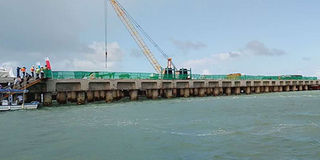Lapsset, coal plant revamp Kililana into investors' paradise

Construction of the first Lapsset berth in Lamu County underway. PHOTO | FILE | NATION MEDIA GROUP
What you need to know:
- Construction of the first three Lapsset berths in Kililana is 60 percent complete, with the first expected to be ready by June, 2019, and the other two in 2020. They will cost Sh48 billion.
- The Sh60 billion Lamu-Garissa-Isiolo Road will also begin in Kililana, where it will link the Lamu port to Garissa, Isiolo, in Samburu County, and Lokichar in Turkana County, joining the Eldoret-Juba Highway.
About a decade ago, no one in Lamu wanted to be associated with Kililana, a village in Lamu West which was known only for mangrove logging and a bit of farming.
Kililana is the local name of a species of mangrove grown mostly in the area.
Between the 1960s and 1980s, many loggers would travel great distances to Kililana to harvest mangroves. At the time, mangrove business was flourishing, with some traders even exporting trees to the Middle East.
Very few people in the area wanted to farm, mostly because they feared their crops would be destroyed by wildlife, which were also a threat to them.
The village remained isolated for a long time, with little hope that it would ever become a bustling economic and industrial hub. But today, Kililana hosts many mega projects initiated by the national government.
COAL PLANT
Perhaps the best-known is the Sh2.5 trillion Lamu Port South Sudan Ethiopia Transport (Lapsset) Corridor, currently under construction.
Construction of the first three Lapsset berths in Kililana is 60 percent complete, with the first expected to be ready by June, 2019, and the other two in 2020. They will cost Sh48 billion.
The second, though somewhat controversial project planned for Kililana village, and which is considered to have huge potential in turning around the economic fortunes of Lamu County, is the proposed Sh200 billion coal-fired power plant.
The project, which is under Amu Power, a venture by Gulf Energy and Centum Investment, is to be located in Kwasasi, which is within Kililana village.
The Sh60 billion Lamu-Garissa-Isiolo Road will also begin in Kililana, where it will link the Lamu port to Garissa, Isiolo, in Samburu County, and Lokichar in Turkana County, joining the Eldoret-Juba Highway.
These projects have drawn great attention to the village, whose profile has risen sharply, making it one of the destination of choice for both investors and speculators in Lamu County.
LAND PRICE
For a long time Kililana had no roads. The village was generally bushy and hard to access. But now, thanks to the Lapsset project, there are a number of roads leading to Kililana.
The various developments have also brought life to the village, with many homesteads springing up.
An investigation by the Nation established that the value of land has skyrocketed.
“Before the advent of these mega projects, you could buy an acre of land for as little as Sh10,000, or even Sh5,000. Today, you cannot buy a piece of land in Kililana, irrespective of the size, for less than Sh1 million,” Mr Ahmed Islam, a land and property agent in the county, said.
In February 2015, for instance, the national government paid out Sh1.3 billion to over 100 landowners in Kililana affected by the Lapsset project. It paid Sh1.5 million per acre.
The move influenced the value of land, with many villagers now demanding more than Sh1.5 million for an acre.
SQUATTERS
But the developments also have a downside. For instance, the village has witnessed increased land-related conflicts, resulting in more squatters. Besides, there is encroachment on the Lapsset project land. There is also massive land grabbing.
Mr Ishaq Khatib, an activist and chairperson of the Lamu Coastal Indigenous People’s Rights for Development, told the Nation that tycoons from as far as Mombasa and Nairobi have already grabbed land in Kililana at the expense of locals, who are now squatters on their own land.
“We have tycoons armed with fake title deeds who have already driven many indigenous residents out of their land. Urgent measures must be taken to stop land grabbing and subsequent landlessness. Almost everyone now wants to own land in Kililana by any means,” he said.
Reports also indicate that some tycoons are taking advantage of locals' illiteracy and paying them very little cash for their land.





